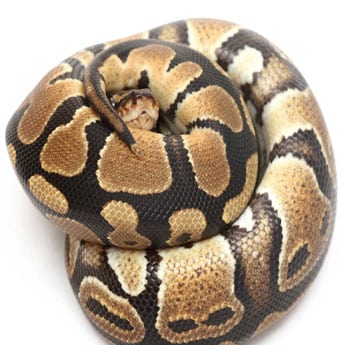Why is my ball python snake refusing to eat?
Q. I bought an adult ball python a couple of months ago. Since then, the ball python snake has only eaten a couple of times and refused to eat the rest. Is there anything else I can do to get my ball python to eat?
A . Ball pythons are often rather shy snakes. In past columns, I covered how to best deal with a ball python that is not eating. If you get a chance, please peruse the archived questions and you should be able to get a detailed answer.
When writing in with a question, it helps tremendously if you provide specific information about your herp’s cage temperature gradient, the focal hot spot temperature, humidity level, cage substrate, normal diet, whether you provide UVB fluorescent lighting and any other pertinent information. If you are unable to provide that information, it means you do not have the correct equipment to properly care for your herp, as thermometers and hygrometers are vital.
It would have helped if you said exactly what your ball python ate when he consumed prey. It also helps to know if a ball python is a captive-bred or wild-caught specimen because wild-caughts may not be used to eating white mice or rats. They may be enticed to eat either brown mice, rats or gerbils, which may look more like native rodents that they consume in the wild. Wild-caughts may also have more problems with internal parasites, and their stress levels may be higher overall because they are not used to people or being handled.
Ball pythons, being shyer by nature, do best when provided with a hide box and some visual barriers to minimize their stress levels. Feed your snake at night because ball pythons are nocturnal.
Make sure you provide your new snake with an appropriate environment and the correct temperature gradient. The day temperature should be 80 to 85 degrees Fahrenheit with a focal hot spot of 90 degrees, and at night, the temperature should not fall below 73 to 75 degrees with a basking area of at least 80 degrees. You should have at least two thermometers, one in the enclosure about 1 inch above the floor, and another at the same height in the basking area. A water bowl large enough for your snake to soak in completely should be provided at all times.
If you make all the changes that I recommended, and your snake still won’t eat, you should make an appointment with a qualified herp veterinarian, so it can undergo a complete physical exam and any necessary tests. Also, if you can bring in a fresh fecal sample (you can refrigerate it until you get to the vet’s office), that would help facilitate fecal testing. If you are concerned that your snake is losing weight, it certainly wouldn’t be a bad thing to schedule an appointment with a herp vet at this time.
I hope this helps. Please take a few minutes to go through the archived questions to learn more about ball python care.
Margaret A. Wissman, DVM, DABVP has been an avian/exotic/herp animal veterinarian since 1981. She is a regular contributor to REPTILES magazine.
Need a Herp Vet?
If you are looking for a herp-knowledgeable veterinarian in your area, a good place to start is by checking the list of members on the Association of Reptilian and Amphibian Veterinarian (ARAV) web site at www.arav.com. Look for DVMs who appear to maintain actual veterinary offices that you could contact.


